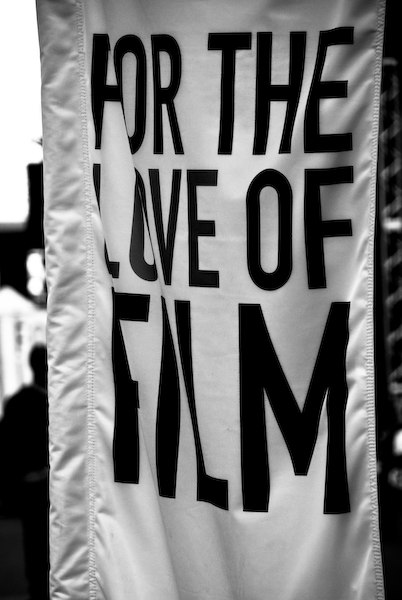Two articles from indieWIRE got me thinking this morning. The first is from the all too familiar Geoffrey Gilmore in ‘Evolution v. Revolution, The State of Independent Film & Festivals.’

A lot of it echoes Mark Gill’s much buzzed ‘The Sky is Falling‘ essay from last year. Basically independent film is in a slump for a few reasons. The main two are the economy sucks so the distribution companies that didn’t get shut down are not buying much ((For a very quick primer on the traditional distribution model, you’d make a film, hope it gets into a prestigious festival such as Sundance, a buyer from a distribution company sees it and loves it, buys the film from you and distributes it making money mainly for them, and if you’re lucky for you as well. Possibly more importantly, you’re film would have had a theatrical release, be known and seen, garnered critical acclaim and awards, and start your career.)), and using submissions to Sundance as a gauge of how many independent films are produced a year, that number has gone up fourfold in the past 10 years.
What does this mean? Compared to 10 years ago, there are four times as many movies with less money to buy and distribute them. The pipes are clogged. Why? Because it’s so cheap and easy to make a movie.
Before I go on, there are two separate issues here: lots of crappy movies and no money to buy and distribute. We’ll start with the crap.
Is Your Idea Worth a Million Dollars?
Film is very expensive. No surprise there. Not only do you have to pay for the film stock, but you have to pay just as much to have it processed and then even more if you want it scanned so you can edit on the computer.
Yet this cost prohibition formed a filter. Crap wouldn’t be made. Because a film is so expensive to make, you’d need people to finance and believe in your project. You’d have to pitch them your idea, which means your idea and story would have to be somewhat decent for them to give you their money. If there was no story, or if you wanted to just film 2 hours of crap, you wouldn’t have the money to do it, and thus the crap would never exist.
Today it’s still just as hard to make a movie well, but because it’s so cheap and easy to make a movie, the crap gets made. When Sundance gets 4000 submissions you know some gems will be overlooked. About 6 years ago I could get my short films (once they were legitimately qualified) to IMDb without an issue. Today my films keep getting wait-listed, and I suspect that’s because anyone who’s made a little film and thrown it on YouTube has submitted it to IMDb, and now they have to sort through thousands of submissions to figure out what’s legit and what’s Charlie biting on fingers.
While it may sound like I want to set off some world-wide EMP and bring us all back to the dark ages (or at least go back to celluloid), I do think overall the digital revolution is great. We just have to have more self control and ask “Is this film worth spending months of my life on?” Or more importantly, “Is this worth two hours of someone’s time?”
Is a Movie a Movie if it’s not in the Movies?
The second problem – no money to buy and distribute films. Here’s the fictional lead from the other article that caught my attention today, ‘Not Picked Up in Park City? Filmmakers Look Forward to DIY Release Options.’
The year is 2014. Joe the Filmmaker just found out he’s going to Sundance with his debut film. His trailer is online the next day. He’s got posters at the printer, and a marketing consultant on the phone. In the days leading up to the festival, he hits up bloggers for press, notifies all his Facebook friends and buys ads both online and in print. After winning a special jury prize for innovation during the final day of the festival, he plugs his movie into the IDN (Indie Distribution Network), selling it directly to indie-minded audiences around the country for viewing on their Internet TVs and iPhones, while a percentage of the proceeds feed directly into his bank account. Done.
This is an echo of what I keep reading – Being picked up by a distributor and getting a theatrical release should not be the only goal. Here’s the standard distribution chain a film follows: it gets theatrically released, goes to DVD, gets on Pay-per-view, then a premium channel (HBO, Starz), cable channel, broadcast.
The internet has shaken that up and challenged that model. When do you put the film on iTunes? Hulu? Do you need a theatrical release? What if you release on DVD and On Demand at the same time? What if it’s available online, ad supported?
The internet has opened a lot of doors. It’s possible to screen, sell, and market your film all by yourself.
But you have to ask yourself, should the goal be “I want people to see my movie” or “I want people to see my movie properly?” There isn’t a single filmmaker who got into directing because they want to premiere their films on someone’s iPhone. If I was Danny Boyle and I saw someone watching Slumdog Millionaire for the first time on their iPhone, I’d shit a brick.
While this argument may sound pretentious, the plain fact is if you’re watching a film on a 3 inch screen in an environment open to distractions you’re missing part of the film.
Again, I don’t want my EMP to wipe out all iPods and iPhones from playing video. Being able to watch anything, anytime, where ever you want is great. I just think some types of media, such as shorts and some docs, work on a computer or iPhone, while others require a theater to get the full experience.
I have my share of movies I love on my phone, and I think it’s the greatest thing that I can watch Jizz in My Pants when I’m stuck in JFK. What’s important to me is first viewing, that magical experience when you pop your cherry with a film.
It goes back thousands of years to the caveman days, sitting around the campfire at night, telling stories. There’s something embedded in us that draws us to this communal experience.
You’re in a dark theater with people you don’t know, experiencing this one story together, going through the same emotions. For two hours you can shut out the world, escape from your problems and share in this experience. You can home theater your house up all you want but you’ll never be able to match the theater experience. Wedding Crashers will never be as funny as the first time I saw it in a packed theater.
Here’s my hope with theaters, and it’s helped in large part with the digital revolution. It’s digital projectors.
Right now most films are still screened from a 35mm print, even if it’s shot digitally. They’re bulky and heavy (expensive to ship) and one print, for one theater, costs thousands of dollars. That’s why it’s expensive and risky to release a movie. Even if you’re doing a very limited release in a few cities, you’re still looking at least $100k to transfer the film, make enough prints and ship them to theaters.
Now here’s the scenario with a digital projector. The film is either sent on a hard drive or over the internet. It’s loaded into the projector and screened. Fast, cheap, and easy.
But it gets better. When a theater books a film it’s a big commitment. They’re saying that you’re film will occupy one of their theaters (they only have 5-24 of them), for the entire week. One, maybe two movies can occupy a theater, because it’s a big hassle to have to switch that huge print to play something different. What if it bombs the first day and then they have six days of an empty theater when they could have put The Dark Knight in there and be bringing in the cash.
Now here’s the digital world. There’s no cost for a print, you just have to get a digital copy to the theater. But they don’t have to play just one movie a day, they can play five different movies throughout the day in the same theater, and stretch them over the week, adopting more of a TV schedule. If a movie does well, they can screen it more. If not, well at least it had a shot that wasn’t an option before.
And what if theaters adopt the technology that powers YouTube and viral videos. Movies are rated, commented on. The more popular movies get more showtimes. Same technology from the web, better viewing experience.
Here’s one of the more thought provoking paragraphs from Geoffrey:
The “long tail” of availability, the keeping of films in the market for longer periods of time is especially important for independent film. And that a film’s release is ordered by an antiquated theatrical universe is one of the fundamental obstacles facing the independent arena. Indeed why are films “seasonal” instead of “evergreen?” The practice of dating films, i.e. assigning a year of release, strikes me as a holdover from the marketing past. How and where films will be made available depends on the establishment of new outlets and new strategies. It simply makes no sense that most of the year’s quality films are all released against each other in a cutthroat fall campaign. In the future perhaps festival platforms could further serve to give films long-term visibility. At the very least new web venues, transformed marketing strategies and dynamic new concepts for consumption are at the core of making films available.
There’s no denying the internet and new media is the future. I think we’re seeing all this hoopla surrounding it because the William Goldman quote still holds true. Nobody knows anything. But it’ll be exciting when someone finally does.

